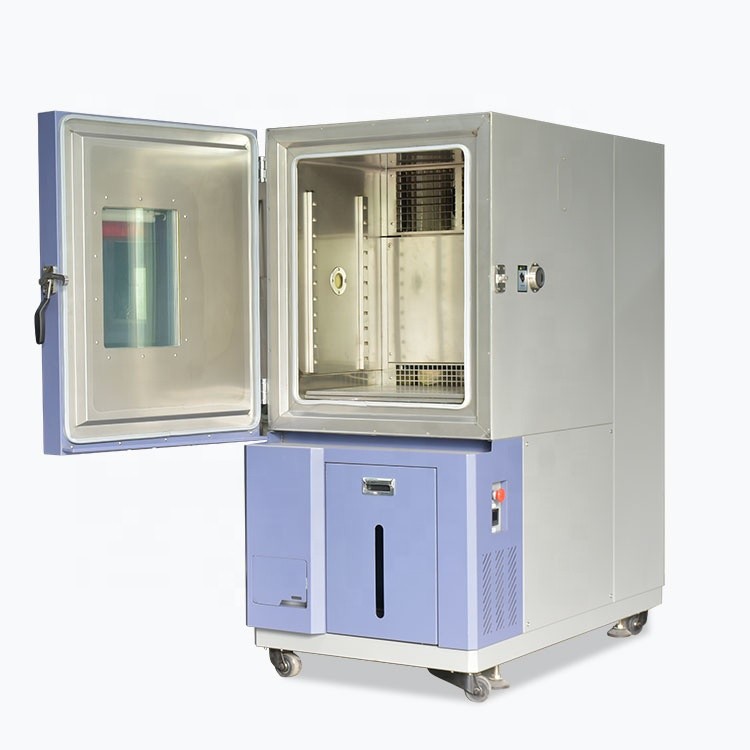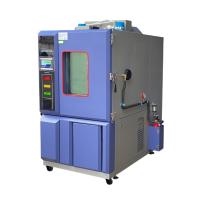New energy batteries are the heart of electric and hybrid vehicles,
playing a pivotal role in determining their performance, range, and
safety. These batteries are exposed to a wide range of temperature
and humidity conditions during their lifespan, which can
significantly impact their capacity, charging efficiency, and
overall durability. Our remote - controlled automotive temperature
humidity test chamber for new energy batteries is a cutting - edge
solution designed to meet the stringent testing requirements of the
automotive new energy industry. This advanced chamber enables
manufacturers, researchers, and quality control teams to subject
new energy batteries to precisely controlled environmental
conditions, simulate real - world scenarios, and ensure the
reliability and performance of these critical components.
The most notable feature of this test chamber is its remote -
controlled operation. Through a dedicated mobile application or a
web - based interface, users can remotely control all aspects of
the test chamber, including temperature, humidity, test duration,
and data logging intervals. This offers unparalleled convenience,
especially when the test chamber is located in a different physical
location or when continuous monitoring and adjustment are required.
Multiple users can access and manage the test chamber
simultaneously, facilitating seamless collaboration between
different departments involved in the battery testing process.
Equipped with state - of - the - art temperature and humidity
control systems, the test chamber provides exceptional precision.
The temperature can be accurately adjusted within a wide range,
typically from - 70°C to 150°C, with a precision of ±0.1°C.
Humidity levels can be controlled from 10% to 95% relative humidity
(RH), with a precision of ±2% RH. This high - level precision
ensures that new energy batteries are tested under exacting
conditions, closely mimicking the diverse environmental scenarios
they may encounter in different geographical locations and usage
patterns.
To accurately evaluate the performance of new energy batteries
under real - world conditions, the test chamber offers a wide
variety of real - world scenario simulation options. It can
replicate the temperature and humidity changes a battery might
experience during a long - distance journey, extreme weather
conditions, or different seasons. Custom - programmed test
sequences can be created to mimic specific usage patterns, such as
rapid charging in high - temperature environments or long - term
storage in humid conditions. This flexibility allows for
comprehensive testing and a more accurate understanding of how new
energy batteries perform in different situations.
A sophisticated monitoring and data logging system is integrated
into the test chamber. Multiple sensors are strategically placed
around the batteries and within the chamber to continuously monitor
temperature, humidity, battery voltage, current, capacity, and
other relevant parameters. The data is logged at high frequencies
and can be accessed and analyzed through the remote - control
interface. This detailed data provides valuable insights into the
battery's performance during the test, enabling manufacturers to
identify potential issues, optimize battery design, and improve
battery management systems.
The test chamber is specifically designed to accommodate different
types and sizes of new energy batteries, including lithium - ion,
lithium - polymer, and solid - state batteries. It features a
spacious interior with adjustable fixtures and supports to ensure
proper positioning of the batteries during the test. The chamber is
equipped with the necessary electrical connections and safety
features to handle high - voltage and high - capacity batteries.
Special provisions are made to monitor and control the charging and
discharging processes of the batteries, allowing for comprehensive
testing of their performance under different operating conditions.
Built to withstand the rigors of continuous use in an automotive
testing environment, the test chamber features a durable and robust
construction. The exterior is made of high - quality, corrosion -
resistant steel that provides excellent protection against physical
damage and environmental factors. The interior is lined with
materials that are resistant to high temperatures, moisture, and
chemicals, ensuring a long - lasting and stable testing
environment. The components of the temperature and humidity control
systems, as well as the monitoring and data logging systems, are
sourced from reliable suppliers and are rigorously tested to ensure
long - term performance and reliability.
Safety is a top priority in the design of the test chamber. It is
equipped with a comprehensive set of safety features, including
over - temperature and over - humidity protection, over - voltage
and over - current protection, fire suppression systems, and
emergency stop buttons. In case of any abnormal conditions, such as
a sudden increase in temperature, humidity, voltage, or current,
the safety systems will automatically activate to prevent damage to
the batteries, the testing equipment, and the personnel. These
safety features ensure a secure testing environment for all users.
| Model | THC-225 | THC-408 | THC-800 | THC-1000 |
| Inside dimension(W x D x H) mm | 50 x 75 x 60 | 60 x 85 x 80 | 100 x 100 x 80 | 100 x 100 x 100 |
| Outside dimension(W x D x H) mm | 75 x 165 x 170 | 85 x 175 x 190 | 125 x 190 x 190 | 125 x 190 x 210 |
| Internal material | #304 Stainless Steel |
| External material | Powder coated #304 Stainless Steel |
| Temperature range | + 150℃~ - 70 ℃ |
| Humidity range | 5% ~ 98% R. H |
| Temperature resolution ℃ | 0.01 |
| Humidity resolution % R. H. | 0.1 |
| Temperature stability ℃ | ±0.3 |
| Humidity stability % R. H. | ±2 |
| High temperature ℃ | 100 | 100 | 100 | 100 |
| Heating time (min) | 20 | 30 | 30 | 30 |
| Low temperature | 0, -40, -70 | 0, -40, -70 | 0, -40, -70 | 0, -40, -70 |
| Cooling time (min) | 20, 50, 70 | 20, 50, 70 | 20, 50, 70 | 20, 50, 70 |
| Air circulation system | Mechanical convection system |
| Cooling system | Imported compressor, fin evaporator, gas condenser |
| Heating system | Sus304 Stainless steel High-speed heater |
| Humidification system | Steam Generator |
| Humidification water supply | Reservoir, Sensor-controller solenoid valve, recovery-recycle
system |
| Controller | Touch panel |
| Electrical power requirements | Please contact us for requirements of specific models |
| Safety device | Circuit system load protection, compressor load protection, control
system load protection, humidifier load protection, overtemperature
load protection, fault warning light |
By subjecting new energy batteries to precise and controlled
temperature and humidity conditions, manufacturers can identify and
address potential performance issues early in the design and
development process. This allows for the optimization of battery
chemistry, cell design, and battery management systems to ensure
maximum performance under different environmental conditions. The
ability to simulate real - world scenarios helps in improving
battery capacity, charging efficiency, and discharge performance,
resulting in longer - range and more reliable electric and hybrid
vehicles.
Testing new energy batteries in a controlled environment helps
manufacturers evaluate the durability of different battery
components and materials. The chamber's ability to replicate
extreme temperature and humidity conditions allows for the
identification of parts that may be prone to degradation,
corrosion, or failure over time. By addressing these issues before
mass production, manufacturers can improve the long - term
durability of their batteries, reducing the need for frequent
replacements and maintenance. This not only benefits the customers
but also enhances the reputation of the automotive brand.
The automotive new energy industry is subject to numerous
international and national regulations regarding battery safety,
performance, and environmental impact. Our test chamber enables
manufacturers to conduct the necessary tests to ensure compliance
with these regulations. By providing accurate and reliable test
data, manufacturers can obtain the required certifications and
approvals, facilitating the sale of their vehicles in different
markets around the world.
Early detection of potential problems through comprehensive testing
in the test chamber can save manufacturers significant costs. By
identifying and fixing issues before mass production, manufacturers
can avoid costly product recalls, warranty claims, and customer
dissatisfaction. The remote - controlled operation of the test
chamber also allows for more efficient testing, reducing the need
for on - site personnel and minimizing testing time. Additionally,
the ability to optimize battery design based on test results can
lead to cost savings in terms of materials, manufacturing
processes, and energy consumption.
For research and development teams in the automotive new energy
industry, the test chamber provides a valuable tool for exploring
new technologies and materials. The ability to precisely control
the temperature and humidity allows for in - depth studies of how
these factors affect the performance of new battery chemistries,
such as solid - state batteries and lithium - sulfur batteries.
This can lead to the development of innovative solutions and the
improvement of existing technologies, giving automotive
manufacturers a competitive edge in the global market.
During the development of new energy batteries, manufacturers use
the test chamber to evaluate the performance of prototypes under
various temperature and humidity conditions. This includes testing
battery capacity, charging and discharging efficiency, cycle life,
and safety features. The test results are used to make design
improvements and ensure that the final product meets the desired
performance and quality standards.
In the manufacturing process, the test chamber is used for quality
control purposes. A sample of new energy batteries from each
production batch is tested in the chamber to ensure that they meet
the specified quality standards. The precise control of temperature
and humidity allows for accurate evaluation of the batteries'
performance, and any issues can be identified and addressed before
the products are shipped to the market.
To evaluate the long - term performance and durability of new
energy batteries, manufacturers conduct battery aging testing in
the test chamber. This involves subjecting the batteries to
repeated cycles of charging and discharging under different
temperature and humidity conditions. The data collected during
these tests helps in predicting the battery's lifespan and
performance degradation over time.
The test chamber is used to conduct safety testing of new energy
batteries. This includes testing the batteries' response to extreme
temperature and humidity conditions, over - voltage and over -
current situations, and short - circuit scenarios. The safety
features of the test chamber ensure that the batteries are tested
in a controlled and secure environment, minimizing the risk of
accidents and ensuring the safety of the end - users.


Our remote - controlled automotive temperature humidity test
chamber for new energy batteries is an essential tool for the
automotive new energy industry. With its advanced features, precise
control, real - world scenario simulation, advanced monitoring and
data logging, battery - specific design, durable construction, and
safety features, it provides a comprehensive and reliable platform
for testing, evaluating, and improving new energy battery
performance. Whether it's for new battery development, quality
control, battery aging testing, or safety testing, this test
chamber is a valuable asset for automotive manufacturers,
researchers, and quality control teams. Contact us today to learn
more about how our product can meet your new energy battery testing
needs.












